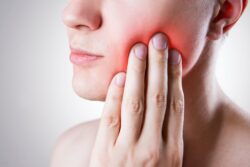During a tooth extraction, a dentist will surgically remove a tooth from its socket in order to protect the health of the rest of your smile. You can anticipate some downtime as you recover from this procedure. And you will notice surgical sites where the tooth was pulled.
Healing blood clots naturally form over these sites, and you must take care not to dislodge or disturb them in any way. If you damage these clots, then you could expose nerves and bone that may result in a serious and painful condition called dry socket.
You will need urgent intervention from your dentist to treat dry socket. So you should make sure you take action to avoid forming this condition in the first place. Find tips to reduce your risk of developing dry socket after a tooth extraction procedure by reading on.

Practice Careful Oral Hygiene
During your recovery from a tooth extraction, you will still need to complete your oral hygiene routine. You must remove plaque and other residues from your smile so that you do not suffer further deterioration of your oral health.
However, you must use gentle, careful movements as you brush and floss your teeth after this treatment, especially near the surgical sites. These hygienic tools could easily hurt a healing blood clot if you do not pay attention to your cleaning methods. Then you could quickly form dry socket.
Follow aftercare guidelines from your dentist to better understand how to keep your smile clean and healthy during this recovery without risking dry socket. If you have questions about this at-home care, feel free to give your dentist a call.
Do Not Perform Sucking Motions with the Mouth
When you try to suck through your mouth, such as using a straw, the combination of airflow and muscle movement will have a high likelihood of disturbing a healing blood clot over extraction sites in the mouth. Then you can likely experience complications like dry socket.
Therefore, you should not use a straw for at least three days after a tooth extraction. Similarly, smoking a cigarette will produce this danger to your oral health as well, so avoid this habit during your recovery. The opposite motion, spitting, can also hurt an extraction site, so make sure you avoid this movement.
Adhere to a Soft-Textured Diet
When you return home after a tooth extraction procedure, your mouth may feel sore as anesthetics wear off. Your dentist will offer you pain management advice so that you can avoid major discomfort during your recovery. You may feel more comfortable sticking to soft-textured foods as well.
But this soft diet will also help you avoid dry socket. Sticky, chewy, and hard foods could easily hurt a healing blood clot over a surgical site. So adhere to this softer diet for at least 48 hours.
Examples of soft foods you can enjoy include yogurt, mashed potatoes, and oatmeal. You can introduce more solid foods to your diet after the first day. But revert back to softer foods if you notice any pain.
